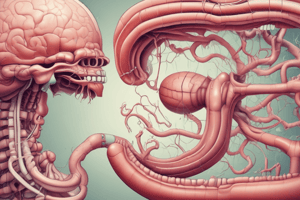Podcast
Questions and Answers
Which part of the stomach is connected to the esophagus?
Which part of the stomach is connected to the esophagus?
- Fundus
- Body
- Cardia (correct)
- Pylorus
What is the J-shaped organ responsible for breaking down food into chyme?
What is the J-shaped organ responsible for breaking down food into chyme?
- Stomach (correct)
- Liver
- Esophagus
- Gallbladder
Which function of the stomach involves absorbing electrolytes like sodium and potassium?
Which function of the stomach involves absorbing electrolytes like sodium and potassium?
- Storage
- Mechanical digestion
- Absorption (correct)
- Chemical digestion
What is the dome-shaped part of the stomach that extends upwards and to the left?
What is the dome-shaped part of the stomach that extends upwards and to the left?
Which part of the small intestine does the pylorus of the stomach lead to?
Which part of the small intestine does the pylorus of the stomach lead to?
Where does the majority of digestion take place in the stomach?
Where does the majority of digestion take place in the stomach?
What is the function of the muscularis externa in the stomach?
What is the function of the muscularis externa in the stomach?
Which layer of the stomach is primarily composed of smooth muscle?
Which layer of the stomach is primarily composed of smooth muscle?
Which artery supplies blood to the lower part of the stomach and the greater curvature of the esophagus?
Which artery supplies blood to the lower part of the stomach and the greater curvature of the esophagus?
Which vessel drains into both the portal vein and the inferior vena cava?
Which vessel drains into both the portal vein and the inferior vena cava?
What is responsible for the relaxation and secretion of the stomach?
What is responsible for the relaxation and secretion of the stomach?
Which layer of the stomach is covered in mucus to protect it from digestive juices?
Which layer of the stomach is covered in mucus to protect it from digestive juices?
Flashcards are hidden until you start studying
Study Notes
The stomach is a part of the digestive system, responsible for breaking down food into chyme, which is then moved into the small intestine for further digestion and nutrient absorption. The stomach is a J-shaped organ located in the upper left region of the abdomen.
Structure of the Stomach
The stomach is divided into four sections: the cardia, fundus, body, and pylorus. The cardia is the upper part of the stomach, which is connected to the esophagus. The fundus is the dome-shaped part of the stomach that extends upwards and to the left. The body, or the main part of the stomach, is where the majority of the digestion takes place. The pylorus is the lower part of the stomach that leads to the small intestine.
Functions of the Stomach
The stomach performs several crucial functions in the digestive process, including:
- Mechanical digestion: The stomach churns the food, breaking it down into smaller pieces, which helps in the enzymatic digestion process.
- Chemical digestion: The stomach secretes various enzymes, such as pepsin, gastric lipase, and mucosal lipase, which help break down proteins, fats, and carbohydrates.
- Absorption: The stomach absorbs some electrolytes, such as sodium and potassium, and small amounts of water and alcohol into the bloodstream.
- Storage: The stomach stores food for up to 4 hours before it is emptied into the small intestine.
Parts of the Stomach
The stomach consists of several parts, including:
- Mucosa: The innermost layer of the stomach, which is covered in a layer of mucus that protects it from the harsh digestive juices.
- Submucosa: The layer beneath the mucosa, which contains blood vessels, lymphatics, and nerve fibers.
- Muscularis externa: The outermost layer of the stomach, made up of two layers of smooth muscle, which helps in the mixing and churning of food.
- Adventitia: The outermost layer of the stomach, which is made up of connective tissue and provides support to the stomach.
Blood Supply to the Stomach
The stomach receives blood from several vessels, including:
- Gastric artery: A branch of the celiac trunk, which supplies the entire stomach except for the lower part, which is supplied by the left gastric artery.
- Left gastric artery: A branch of the celiac trunk, which supplies blood to the lower part of the stomach and the greater curvature of the esophagus.
- Gastric veins: Drain into the portal vein and the inferior vena cava.
Nerve Supply to the Stomach
The stomach is innervated by the parasympathetic nervous system, which is responsible for the relaxation and secretion of the stomach. The vagus nerve, a cranial nerve, plays a significant role in this innervation.
Studying That Suits You
Use AI to generate personalized quizzes and flashcards to suit your learning preferences.




